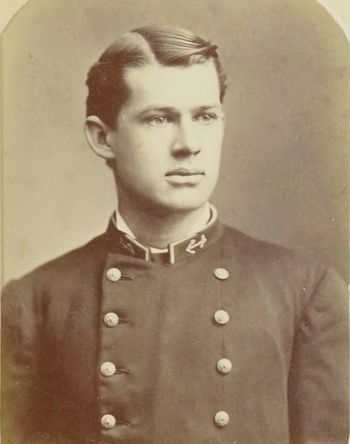STEVENSON B. MALLORY, ENS, USN
Stevenson Mallory '76
Stevenson Blount Mallory was admitted to the Naval Academy from Virginia on June 12, 1872 at age 16 years 0 months.
Prior to the publication of the Lucky Bag in 1894, most portraits of officers and midshipmen of the Naval Academy were captured in yearly photo albums. The album for 1876 is available in the collections of the Naval Academy's Digital Collections.
Special thank you to historian Kathy Franz for identifying this resource and then extracting several dozen photographs for this site.

Prior to the publication of the Lucky Bag in 1894, most portraits of officers and midshipmen of the Naval Academy were captured in yearly photo albums. The album for 1876 is available in the collections of the Naval Academy's Digital Collections.
Special thank you to historian Kathy Franz for identifying this resource and then extracting several dozen photographs for this site.
Loss
Stevenson died of yellow fever on November 14, 1878, at the Civil Hospital, Frederiksted, Santa Cruz, W.I., while serving aboard USS Plymouth.
Other Information
From researcher Kathy Franz:
Stevenson was born into a well-known and respected family in Hampton on the Peninsula of Virginia. His grandfather, a colonel, died in a Revolutionary War battle right before Yorktown. His father was Colonel Charles K. Mallory, plantation owner and attorney. His mother was Martha, and his brothers were Charles, Edmund, Francis, and John. His sisters were Frances, Martha, and Lavinia; and the children who died in infancy were Kennon, Emily, and Thomas.
Just as his father was serving on the Virginia Constitutional Convention of 1861, three of their slaves escaped to the Union’s Fortress Monroe on May 23, 1861. His father sent a representative under a white flag of truce to see General B. F. Butler. He stated that under the Fugitive Slave Act of 1850, the slaves must be returned to their owner. Butler disagreed that this act applied during the War. He said they would be confiscated as “contraband” property, and he put them to work. This was the first known instance of this, and it became the Union standard later by Abraham Lincoln’s authorization. The Mallory’s mansion and plantations were also confiscated.
After the war, Stevenson was attending William and Mary College when he was appointed to the Naval Academy. He along with two of his brothers died while serving on ships. In June 1863, his oldest brother Charles died when the boiler exploded on the CSS Chattahoochee at Columbus, Georgia. Francis died while serving on the brig Chattanooga out of Baltimore. He was trying to get from the shore to the ship during a hurricane at St. Thomas, West Indies, in April 1874.
Stevenson died in November 1878 while serving on the Plymouth. From: The Virginia Magazine of History and Biography, Vol XV, No. 1, July 1907, as published in the Norfolk Landmark in 1878.
“About the 2d instant, while the U.S. steamer Plymouth was lying in the harbor of Santa Cruz, Mr. Mallory and another midshipman named Anthony W. Rollins went ashore and remained several hours. The weather was very warm, and upon their return to the ship both were in a state of profuse perspiration. They took seats upon the forecastle to enjoy the cool breeze, and it is supposed that Mallory contracted a cold, as he was taken sick the next day, and soon was suffering from a well-developed attack of yellow fever. There was only one other person sick on board, a sailor, and it was not known at the time that his disease was yellow fever, but it proved so afterwards.
Mr. Mallory was taken ashore, and placed in the hospital, and although quite seriously sick for a while he had so far recovered when the Plymouth sailed on the 7th instant as to walk about the hospital.
Mr. Rollins (Anthony Rollins '76) was taken with the fever a day or two before the steamer sailed, and was very sick when she left that port. The young gentlemen were left to the care of American Vice-Consul, who had showed them every attention and kindness. The dispatch received Tuesday contained the sad information that both were dead.
Yesterday Captain Harmony forwarded Mr. Mallory’s effect to his brother at Jackson, Tenn. Midshipman Mallory was a highly-esteemed and popular young gentleman, and stood high in the opinion of his superior officers. His untimely death will be deeply lamented by a large number of relatives and friends.”
Stevenson had the buttons from the dress uniform of his late brother Charles who served in the Confederate States Army. He had the buttons converted by Tiffany & Company of New York into a pair of cuff buttons with stem and clasp of gold. The design was a pair of cannons crossed under an anchor with the raised letters C. S. N. The faces were burnished with gold and looked as fresh and bright as when new. Their sister Fanny gave the buttons to her nephew Charles K. Mallory (Class of 1895) upon his cruise on the Minneapolis. This Charles also named his son Charles who graduated from the Naval Academy in the Class of 1932. He died in a plane crash in 1936.
Stevenson’s father was Col. Charles K. Mallory. His brother Charles was at the battle of Hampton Roads in which the USS Congress and Cumberland were destroyed by the Virginia (Merrimac.) He was killed on the Confederate �steamer Chattahoochee in 1863. After the Civil War, brother John went to West Point and later became a Brigadier General.
He is pictured in a photo montage of Plymouth's officers.
Stevenson is buried in Frederiksted, Santa Cruz, West Indies.
Related Articles
Anthony Rollins '76 was also serving aboard Plymouth when he died, at the same hospital, four days earlier.
Memorial Hall Error
Illness is not a criteria for inclusion in Memorial Hall.

The "category" links below lead to lists of related Honorees; use them to explore further the service and sacrifice of alumni in Memorial Hall.